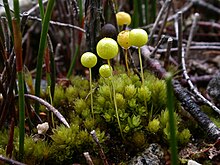| Pleurophascum grandiglobum | |
|---|---|

| |
| P. grandiblogum, growing on the subalpine buttongrass moorlands along Gelignite creek, Scotts Peak Dam Road | |
| Scientific classification | |
| Kingdom: | Plantae |
| Division: | Bryophyta |
| Class: | Bryopsida |
| Subclass: | Dicranidae |
| Order: | Pottiales |
| Family: | Pleurophascaceae |
| Genus: | Pleurophascum |
| Species: | P. grandiglobum
|
| Binomial name | |
| Pleurophascum grandiglobum | |
Pleurophascum grandiglobum is a moss endemic to Tasmania, Australia, and was first noted by S. O. Lindberg in 1875 for its peculiar form of cleistocarpous capsule, erect growth form, lateral perichaetia, and ecostate leaves.[1] Its exceedingly large, inoperculate, and often brightly coloured capsules captured the heart of the 19th-century Scandinavian bryologist, who considered the moss to be "of no less interest to the Museologist than is Rafflesia or Welwitschia to the Phanerogamist".[2] The species currently belongs to a monogeneric family Pleurophascaceae that is found only in temperate Australasia[2] and includes three different species. Pleurophascum ovalifolium, heretofore known as P. grandiglobum var. decurrens, is the New Zealand taxon while the last remaining member of the genus, Pleurophascum occidentale, occurs only in Western Australia.[1]
The relationship between P. grandiglobum and P. ovalifolium has been puzzling botanists such as Sainsbury for more than 50 years, and it was not until recently (around 2005) that the New Zealand representative, which was restricted to the vicinity of Mt Arthur on the western coast of South Island, was recognised and given a new name.[1][2] Probably the most discerning features of P. ovalifolium that separates it from P. grandiglobum are its distally erect leaf margins and bright orange-red capsules that become strongly discoid when mature [1](P. grandiglobum has a recurved distal leaf margin and orange-green capsules when mature).[1][3]
P. occidentale, on the other hand, is only found along coastal heaths in the southwest of Western Australia and has dramatically different morphological characteristics compared to its two congeners [2].[1][3] These features include: (1) sexual organs borne terminally on secondary stems and branching that is predominantly (or exclusively) by subperigonial and subperichaetial innovation (in both P. grandiglobum and P. ovalifolium inflorescences of both sexes occur on lateral branches and lack true innovations); (2) absence of stomata at the capsule base; and (3) very short setae and short-exserted capsules and suggest a longer period of isolation than between its cousins.[1]
The name Pleurophascum originates from the Greek word pleuron, meaning lateral, whereas phascon refers to an indeterminate cryptogam, and together they describe the capsules of P. grandiglobum arising from short, lateral branches.[4]
- ^ a b c d e f Fife, A.J., Dalton, P. J. (2005). "A reconsideration of Pleurophascum (Musci : Pleurophascaceae) and specific status for a New Zealand endemic, Pleurophascum ovalifolium stat. et nom. nov". New Zealand Journal of Botany. 43 (4): 871–884. doi:10.1080/0028825X.2005.9512997. S2CID 85968596.
{{cite journal}}: CS1 maint: multiple names: authors list (link) - ^ a b c Fife, A. J. (1951). "Pleurophascaceae". In Heenan, P.B.; Breitwieser, I.; Wilton, A.D. (eds.). Flora of New Zealand - Mosses. Fascicle 25. Manaaki Whenua Press. doi:10.7931/B1F596.
- ^ a b Meagher, D., Fuhrer, B. (2003). A field guide to the mosses and allied plants of Southern Australia. Victoria: Australian Biological Resources Study & The Field Naturalists Club of Victoria. p. 102.
{{cite book}}: CS1 maint: multiple names: authors list (link) - ^ Catcheside, D. G. "Pleurophascaceae" (PDF).